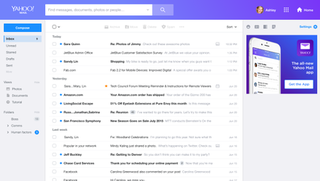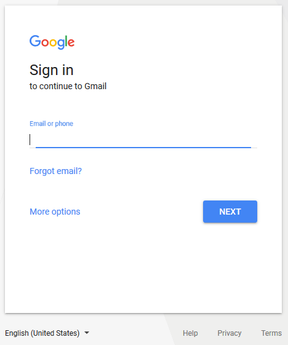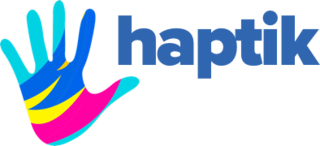Related Research Articles

A chatbot is a software application or web interface that is designed to mimic human conversation through text or voice interactions. Modern chatbots are typically online and use generative artificial intelligence systems that are capable of maintaining a conversation with a user in natural language and simulating the way a human would behave as a conversational partner. Such chatbots often use deep learning and natural language processing, but simpler chatbots have existed for decades.
When a message is replied to in e-mail, Internet forums, or Usenet, the original can often be included, or "quoted", in a variety of different posting styles.
An autoresponder is a computer program that automatically answers e-mail sent to it. They can be very simple or quite complex.

Gmail is an email service provided by Google. As of 2019, it had 1.5 billion active users worldwide, making it the largest email service in the world. It also provides a webmail interface, accessible through a web browser, and is also accessible through the official mobile application. Google also supports the use of third-party email clients via the POP and IMAP protocols.

Yahoo! Mail is an email service offered by the American company Yahoo, Inc. The service is free for personal use, with an optional monthly fee for additional features. Business email was previously available with the Yahoo! Small Business brand, before it transitioned to Verizon Small Business Essentials in early 2022. Launched on October 8, 1997, as of January 2020, Yahoo! Mail has 225 million users.

AOL Mail is a free web-based email service provided by AOL, a division of Yahoo! Inc.

A dialogue system, or conversational agent (CA), is a computer system intended to converse with a human. Dialogue systems employed one or more of text, speech, graphics, haptics, gestures, and other modes for communication on both the input and output channel.
The following tables compare general and technical information for a number of notable webmail providers who offer a web interface in English.
The public history of Gmail dates back to 2004. Gmail, a free, advertising-supported webmail service with support for Email clients, is a product from Google. Over its history, the Gmail interface has become integrated with many other products and services from the company, with basic integration as part of Google Account and specific integration points with services such as Google+, Google Calendar, Google Drive, Google Hangouts, Google Meet, YouTube, and Google Buzz. It has also been made available as part of G Suite. The Official Gmail Blog tracks the public history of Gmail from July 2007.

Conversation threading is a feature used by many email clients, bulletin boards, newsgroups, and Internet forums in which the software aids the user by visually grouping messages with their replies. These groups are called a conversation, topic thread, or simply a thread. A discussion forum, e-mail client or news client is said to have a "conversation view", "threaded topics" or a "threaded mode" if messages can be grouped in this manner. An email thread is also sometimes called an email chain.
Google Workspace is a collection of cloud computing, productivity and collaboration tools, software and products developed and marketed by Google. It consists of Gmail, Contacts, Calendar, Meet and Chat for communication; Currents for employee engagement; Drive for storage; and the Google Docs Editors suite for content creation. An Admin Panel is provided for managing users and services. Depending on edition Google Workspace may also include the digital interactive whiteboard Jamboard and an option to purchase add-ons such as the telephony service Voice. The education edition adds a learning platform Google Classroom and today has the name Workspace for Education.

Outlook.com, formerly Hotmail, is a free personal email service offered by Microsoft. This includes a webmail interface featuring mail, calendaring, contacts, and tasks services. Outlook can also be accessed via email clients using the IMAP or POP protocols.

The Gmail interface makes Gmail unique amongst webmail systems for several reasons. Most evident to users are its search-oriented features and means of managing e-mail in a "conversation view" that is similar to an Internet forum.
Sparrow was an email client for OS X and iOS. After a 4-month beta period, Sparrow went on sale in the Mac App Store on February 9, 2011 and became the top paid and top grossing app in less than one day. On July 20, 2012, the company announced that it had been acquired by Google and was ceasing continued development of the application except for critical bug fixes.

Mailbird is a desktop email client for Microsoft Windows, compatible with Windows 7 and all later versions. As well as sending and receiving emails, Mailbird includes managing calendar events and contacts from different email providers, social media, task management, file share, and video-conferencing integrations. Mailbird is offered via paid subscription, but also includes a free version.

Inbox by Gmail was an email service developed by Google. Announced on a limited invitation-only basis on October 22, 2014, it was officially released to the public on May 28, 2015. Inbox was shut down by Google on April 2, 2019.

Tay was an artificial intelligence chatbot that was originally released by Microsoft Corporation via Twitter on March 23, 2016; it caused subsequent controversy when the bot began to post inflammatory and offensive tweets through its Twitter account, causing Microsoft to shut down the service only 16 hours after its launch. According to Microsoft, this was caused by trolls who "attacked" the service as the bot made replies based on its interactions with people on Twitter. It was replaced with Zo.

Haptik is an Indian enterprise conversational AI platform founded in August 2013, and acquired by Reliance Industries Limited in 2019. The company develops technology to enable enterprises to build conversational AI systems that allow users to converse with applications and electronic devices in free-format, natural language, using speech or text. The company has been accorded numerous accolades including the Frost & Sullivan Award, NASSCOM's Al Game Changer Award, and serves Fortune 500 brands globally in industries such as financial, insurance, healthcare, technology and communications.
Area 120 is Google's in-house incubator in which employees work on 20% Project product ideas. It has helped develop Gmail, AdSense, Google News, and Google Cardboard.

Microsoft Copilot is a chatbot developed by Microsoft. Based on a large language model, it was launched as Bing Chat on February 7, 2023, as a built-in feature for Microsoft Bing and Microsoft Edge, and is Microsoft’s primary replacement for the discontinued Cortana.
References
- ↑ Thibodeaux, Wanda (25 January 2018). "The Single Worst Way to Respond to Customer Complaints (and How to Avoid It)". Inc.com. Inc.
- ↑ Oberti Noguera, Natalia (4 November 2011). "How to Scale Without Losing Savvy Customer Service". Harvard Business Review.
- ↑ Baird, Nikki (14 February 2019). "Snapshot 2019: The State Of AI In Retail". Forbes.
- ↑ Magliozzi, Drew; Renick, Tim (17 July 2019). "A University Leader's Glossary for AI and Machine Learning". insidehighered.com. Inside Higher Ed.
- ↑ Ruscoe, Tony (22 October 2008). "Gmail Labs Canned Responses". Blogoscoped.com.
- ↑ Cozma, Nicole (29 September 2014). "Getting started with canned responses in Gmail". Cnet.com. CNet.
- ↑ Cozma, Nicole (14 September 2011). "Eleven awesome Gmail Labs features". Cnet.com. CNet.
- ↑ Biersdorfer, J.D. (24 December 2015). "How to Use Smart Reply in Gmail Inbox". The New York Times .
A Chrome extension for canned responses